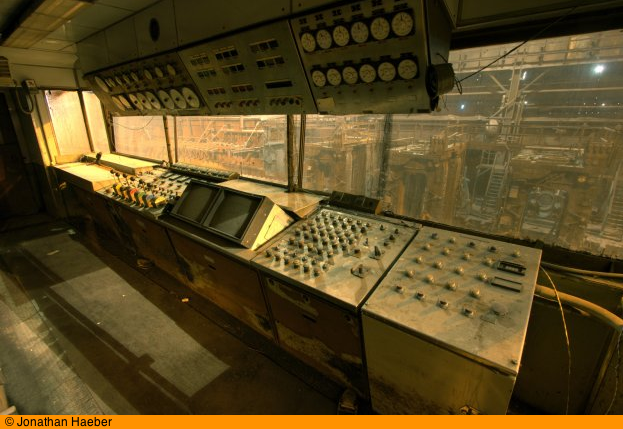Urbex at its finest.
I suspect a key reason that urban exploration photography so appeals to me is that you see the recent past through the mantle of a veil of decay and decrepitude. What was once vibrant and magnificent is now sad and rotted. The decay somehow heightens the sense of a locations magnificent past. It’s also no surprise that probably the best urbex work is being done in America for no other nation places so little value on the appearance of its land. A car is old? Dump it in the field. A factory closed? Place barbed wire around it and let it rot. Cheaper than flattening it. Seldom, it seems, is any attempt made to raze and redevelop the land which created so much wealth back then.
Jonathan Haeber, that prince of urbex artists, took his team to McLouth Steel in crumbling Detroit. He relates that McLouth was once one of America’s largest steel producers. The photographs accompanying his article are outstanding and very worthy of your time. Click his magnificently lit picture below to see more.

Click the picture for Haeber’s documentation of McLouth Steel.
If you are interested in American industrial history, there’s no finer way of getting a snapshot than the chart put out by Financial Graph & Art of the changes in the Dow Jones Industrial Average of common stocks from its inception in 1896, when it numbered 20 stocks. Today it’s 30. You don’t have to be a money management maven to appreciate what this chart shows. For example, in 1896, fully 50% of the Dow was comprised of metal, mining and rail, with agriculture the runner up at 25%. America made things. Finance (which produces nothing) and retail (which has us spending what we do not have) were mere slivers. Today? Finance – one third. Retail – one third. Everything else – the remainder. America borrows to buy garbage. The chart also shows how very few businesses survive for long and just how wild some of the market’s swings have been through our never ending booms and busts. I gaze at this chart often and never fail to learn something new. Just like Haeber’s photographs.
I seem to have a soft spot for anything that is worn down that was once so great. Photos of buildings and objects that are forgotten just inspire you to think of what they once were.
I worked there for nearly 10 years from 1970 and watched as the union and the executives slowly bled the company to death. Every time a new contract was signed the union would wildcat strike while the executives would be stealing from our pension fund behind our backs. On hundreds of occasions I saw people working double and triple shifts but only producing about 15 minutes of work and sleeping or drunk the rest of the time. Fatalities were a daily event. They had vacation plans that were ridiculous. The senior hourly employees would get up to six months a year off for vacation. I loved working in the steel industry but it’s too bad places like this were rotted from the inside by greed.